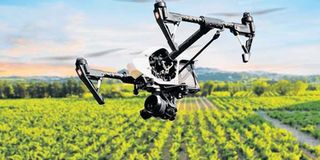For Agra, tech is a key tool in transformation of agriculture

In this picture, a drone is being used in the monitoring of crops. PHOTO|FILE
INTERVIEW. The head in Tanzania of the Alliance for a Green Revolution in Africa (Agra) says agriculture in Tanzania is not lagging behind. Transformation is happening. The country has maintained food self-sufficiency for more than ten (10) years now. With an increasing population, this means improvement is happening. The next step is to transform what is regarded as ‘traditional food crops’ into ‘today’s cash crops...’
Precision agriculture, satellite farming or site-specific crop management is a farming management concept based on observing, measuring and responding to inter- and intra-field variability in crops. The Alliance for a Green Revolution in Africa (Agra) is one of the organizations that are spearheading the precision agriculture concept in Africa. In this interview with Seif Kabelele, the Agra country director for Tanzania, Mr Vianey Rweyendela, explains. Read on:
From your point of view: what is the situation regarding ‘precision farming’ in Tanzania?
Precision farming is the way forward. The use of drones, Global Positioning System (GPS) and specific soil fertilization will provide better monitoring of crops and yields.
What predetermines the difference in capacities for adapting technologies by different farmers? Do all farmers need to switch to ‘precision farming?’
Economic strata. Being excited about technology is one dimension; affording it is another. As such, financial instruments are required for every technology that is being advocated.
What would you advise agriculturists who want to get started on ‘precision farming?’
Get the right technologies in the right place. Avoid ‘copy and pasting’ without adapting the state of the environment.
Where do you wish we could be making progress faster in Tanzanian agriculture?
Market coordination and data availability in agribusinesses.
What’s the most pressing issues in technology and agriculture that you’d like to see solved?
Financing; improved technologies.
Do you perceive a gap between availability and the adoption of appropriate tech in Agriculture?
Yes, accessibility of promoted technologies in abundance and timely manner to a majority of smallholders is still a challenge.
In general terms: what’s the role of the youth in the continuity of farming - especially in an era when most smallholder farmers are ageing, while their farms still need to be farmed, crops harvested - yet the youth are least interested in farming the traditional way?
The only way to bring youth into this space is by bringing in innovations. ICTs are one of them. Mechanization and irrigation are others. These are game-changers in today’s agricultural environment.
What is really holding back the agricultural sector in Tanzania, in your view – given the market demand?
Agriculture in Tanzania is not held back. Transformation is happening. This country has maintained food self-sufficiency for more than ten years now.
With the increasing population, this means improvement is happening.
The next step is to transform what is regarded as ‘traditional food crops’ into ‘today’s cash crops.’




